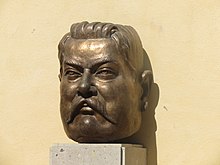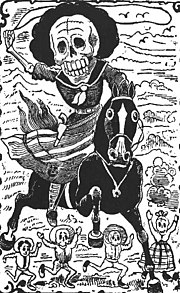Jose Guadalupe Posada
José Guadalupe Posada Aguilar (Aguascalientes, February 2, 1852 - Mexico City, January 20, 1913) was a Mexican engraver, illustrator and caricaturist. He is famous for his drawings of customs, folkloric scenes, socio-political criticism and for his illustrations of "calacas" or skulls, including La Catrina.
Biography
José Guadalupe Posada Aguilar was born on February 2, 1852 in the city of Aguascalientes. He possessed a natural talent for engraving, after learning to read and write with his brother José Cirilo Posada, and overcoming stubborn family opposition, he entered the Municipal Drawing Academy of Aguascalientes. Later, in 1868, he entered the lithographic workshop of Trinidad Pedroza as an apprentice. Some of the first cartoons of political criticism of him were published in El Jicote, a newspaper in opposition to the government of Jesús Gómez Portugal. He began his career by making drawings, copying religious images and as an assistant in a pottery workshop.
In 1872, Posada and Pedroza decided to settle in León, Guanajuato, where they both dedicated themselves to commercial lithography. In the city of León, Posada opened his own workshop and later worked as a lithography teacher at the Secondary School, likewise, he made lithographs and wood engravings that illustrated matchboxes, documents, and books. In that same city, he married María de Jesús Vela in 1875. The following year he bought the printing press from Trinidad Pedroza. From 1875 to 1888 he continued to collaborate for various newspapers in León, including La Gacetilla, The Chaotic Town and Education.
In the magazine La Patria Ilustrada, directed by Arturo Paz, he published. At the end of 1888 he moved to Mexico City, where he learned the trade of lead and zinc engraving techniques. He collaborated for the newspaper La Patria Ilustrada and the Revista de México until the first months of 1888.
He began to work with Antonio Vanegas Arroyo, it has been claimed that he worked as his employee, but this is not true, it is shown in the same photograph that is known at the entrance to his workshop, where his activities are announced. The news of his life is rather personal and isolated: In January 1900, three newspapers, El Chisme, El Diario del Hogar and El Popular, give you their condolences on the death of your son Juan Sabino. In 1908 it was announced that he won one hundred pesos in the Lottery.
There were many and varied workshops, printers and newspapers in which Posada worked: La Juventud Literaria, from the Revista de México, La Patria Ilustrada and El padre Cobos; Later he joined the group of newspapers of Francisco Montes de Oca: El Gil Blas, El Popular, Argos, El Chisme . Posada undertook a job that earned him popular acceptance and admiration, due to his sense of humor, propensity for the dramatic, and plastic quality. In his wide and varied work, Posada portrayed the beliefs and daily ways of life of popular groups, criticizing the abuses of the government and the exploitation of the people. In addition, he illustrated the famous "calaveras", verses alluding to death that, along with his other illustrations, were distributed in newspapers and loose sheets. In 1893 he collaborated irregularly for the newspaper Gil Blas which was aimed at the poor class of the town and with anti-Porfirio overtones; Despite his varied and popular work, the engraver was not as recognized as other contemporary artists. It was not until after his death that he began to value his aesthetics as true popular art, and specifically thanks to the recognition of Diego Rivera, who gave his work great diffusion.
He lived and died virtually anonymous and was only recognized many years later. He died of alcoholism in the Tepito neighborhood, in Mexico City, at the age of 61, on January 20, 1913 and was buried in an unidentified grave in the Panteón de Dolores. He would be lucky not to live through the horrors of the Tragic Ten and the Victoriano Huerta regime, and he would not live to witness the triumphant entry of Villa and Zapata in December 1914.
He described with originality the spirit of the Mexican people from political affairs, daily life, their terror for the end of the century and the end of the world, as well as natural disasters, religious beliefs and magic. Due to the style and subject matter of his employees, José Guadalupe Posada is considered a popular artist, coming from the town, who nurtured his work from the popular Mexican imaginary and to whom he addressed himself as an audience.
He was considered by Diego Rivera as the prototype of the artist of the people and his most seasoned defender, he even proclaimed himself as the son of Posada and Catrina in his mural Dream of a Sunday afternoon in the Alameda. He is also considered a precursor of the Mexican nationalist movement of plastic arts, muralism. He is famous for his drawings and engravings on death. He passionate about drawing political caricature. He developed new printing techniques. He worked and founded major newspapers. He consolidated the Day of the Dead festival, through his interpretations of daily life and attitudes of the Mexican through skulls acting as common people.
Style
Posada's critical images were evidence of the inequality and social injustice existing in the Porfirian era, they questioned his morality and his cult of modernity, however this work was not substantive since he took care of his editorial line.
Newspaper Illustrator
During his work as a newspaper illustrator, José Guadalupe soon revealed himself as an extraordinary cartoonist, often contrary to the rules of Mexican academic painting, in force until the early years of the 20th century. However, his best skills were in engraving and, above all, in a new, coarser and more vigorous technique: lithography. Posada was an excellent metal engraver,
He made illustrations and political caricatures for various printers and some newspapers. In his fruitful creative life, he was persecuted and attacked, because he always emphasized his theme by criticizing and denouncing atrocities and injustices committed by the regimes that ruled the country.
Posada is an artist present in the daily life of society. In his work he rescues relevant national historical episodes and describes Mexican society in times of war. His work spread rapidly through multicolored flyers, simple papers capable of being blown by the wind, but present in everyday life. In La Patria Ilustrada the lithographer develops a costumbrista work, that is, aimed at the elite, but which falls within the tradition of liberal, nationalist and progressive graphics. In the illustrations that he made for the Vanegas Arroyo and Montes de Oca printers, he kept the liberal and costumbrista approach but made graphics of a purely cultural nature. In Gil Blas Cómico, El Popular, Diablito Joker and other publications, the artist makes caricatures that criticize the abuses and inconsistencies of the Porfirian regime.
Inn
From the outbreak of the Mexican Revolution of 1910 until his death in 1913, the teacher Posada worked tirelessly in the press aimed at workers. His first works, carried out in workshops and small printers, gave him the opportunity to develop his artistic skills as a draughtsman, engraver and lithographer; At that time, he made some satirical illustrations that appeared in the magazine El Jicote . He was critical of the government of Francisco I. Madero and of the campaigns carried out by Emiliano Zapata.
He illustrated corridos, stories of crimes and passions, of ghosts and miracles. He portrayed and caricatured all kinds of characters: revolutionaries, politicians, those shot, drunkards, peladitos, bandits, catrinas, elegant ladies, charros, bullfighters, and workers. He also illustrated the famous & # 34; calaveras & # 34; (verses alluding to death that were illustrated with living skeletons personified) a genre that Posada developed in an extraordinary way. He clothed the skeleton in the skull: the essence of the sorrows and joys of the people.
A great draftsman, tireless worker and a great engraving technician, Posada died as poor as he was born, on January 20, 1913 in Mexico City.
Skulls
Posada's skulls are in most cases associated with the Day of the Dead, since he interpreted the life and social attitudes of the Mexican people, represented in his engravings with skulls dressed in finery, skulls at neighborhood parties, in urban streets, in the houses of the rich. He drew skulls mounted on horseback, on bicycles, with which he pointed out the scourges, the misery and the political errors of the country. If it is the original case of La Catrina or La Calavera garbancera, taken up again years later by Diego Rivera, the engraving represents a mockery of the enriched indigenous people during the Porfiriato who despised their origins and customs, copying European fashions.
In The Labyrinth of Solitude Octavio Paz mentions: “Death is a mirror that reflects the vain gesticulations of life (…) A society that denies death also denies life". This is a vision of death compatible with Posada's skull engravings, since they represent a perspective of the Mexican who did not fear death but the anguish of life, because in it man is easy prey of snares and sufferings.
The skulls were a fusion of pre-Columbian, colonial and popular visions, which, more than capturing a solemn and dramatic feeling, were a jocular, fun illustration full of vitality. The difference in the representation of death in Posada's engravings is that it seems to enjoy everyday life without scaring anyone, which transcends the first and second of November. His skulls are part of an expression of popular art, they are a creation in which the name of the author and the time are lost, remaining embodied in history.
Influence
The initial influence was given by Manuel Manilla (1830 (approximately) - 1895) a Mexican engraver who was the first caricaturist of these images, later Posada eclipsed his style, with this there is no doubt that the works of Manilla and Posada they influenced later artists such as José Clemente Orozco, Diego Rivera, Francisco Díaz de León and Leopoldo Méndez, among others.[citation required]
His works are preserved, among other institutions, by the National Institute of Fine Arts, the José Guadalupe Posada Museum in Aguascalientes and the Museum of Graphic Arts in Saltillo, Coahuila, in addition to private collections. There is also a digital collection of more than 500 works at the Instituto Iberoamericano in Berlin.
Posada had a very wide production of drawings, posters and engravings that were distributed in all regions of the republic, totaling at least five million copies.
The recovery of Posada's iconography did not end with the generation of post-revolutionary artists, rather it became a constant source of inspiration for the following generations, multiplying and diversifying according to the particular ways of interpreting the messages transmitted by his worked.
The validity of the work of José Guadalupe Posada is clearly identified in a series of creations achieved in recent decades, using various media and techniques. Posada beyond his death, and his death, lives and is an important presence and cultural expression of Mexican art.
Contenido relacionado
Appeals
Alexander III Bridge
Olympe de Gouges



